二语习得定义题
《二语言习得研究》课件

语调技巧:通过调整语调来表达不同的情感和态度,使口语更加丰富和生动
词汇积累:扩大词汇量,掌握常用短语和表达方式,提高口语表达能力
语法运用:正确运用语法规则,避免语法错误,使口语更加规范和准确
阅读技巧与方法
泛读:快速浏览全文,把握文章大意
精读:逐句阅读,深入理解文章内容
略读:快速查找特定信息
批注阅读:边读边思考,记录心得和疑问
定义:社会文化理论是一种研究语言习得过程中社会文化因素的理论
代表人物:Vygotsky
社会文化理论的应用:在二语言习得中,社会文化因素如语言环境、母语干扰等对学习者产生影响
二语言习得策略
04
记忆策略
联想记忆法:通过联想与记忆对象相关的其他事物来提高记忆效果
图像记忆法:将记忆对象转化为图像或图表,以便更好地理解和记忆
写作技巧与方法
撰写研究报告和论文
制定研究计划和时间表
收集相关资料和数据
确定研究主题和目的
二语言习得中的问题与对策
06
学习动机不足问题与对策
学习动机不足的原因:缺乏兴趣、目标不明确、自信心不足等
对策:提高学习兴趣、明确学习目标、增强自信心等
具体措施:选择有趣的学习材料、制定合理的学习计划、鼓励自我肯定等
二明扼要地阐述您的观点根据需要可酌情增减文字
对策:通过多听多说、注重基础知识的掌握、了解目标语言的文化背景等方式来提高二语言习得的效果。
单击添加文本具体内容,简明扼要地阐述您的观点根据需要可酌情增减文字
学习效果不佳问题与对策
学习效果不佳的原因:缺乏学习动机、学习策略不当、语言环境不佳等
元认知策略
定义:元认知策略是指学习者对自己学习过程的有效监视和控制的策略
二语习得教案考试重点

二语习得教案考试重点第一章:二语习得概述1.1 定义:二语习得是指学习者在掌握母语的基础上,习得一种非母语的过程。
1.2 重要性:二语习得对于个人发展、跨文化交流和国际合作具有重要意义。
1.3 二语习得与母语习得的区别:探讨二语习得与母语习得之间的相似之处和差异。
1.4 二语习得的主要理论:介绍行为主义、认知主义、交际法和交际语言教学等理论。
第二章:二语习得的影响因素2.1 个人因素:年龄、性别、认知能力、学习动机等对二语习得的影响。
2.2 社会因素:社会环境、文化背景、语言接触等对二语习得的影响。
2.3 教育因素:教学方法、教材、教师素质等对二语习得的影响。
2.4 语言因素:语法、词汇、发音等语言要素对二语习得的影响。
第三章:二语习得的过程与阶段3.1 刺激阶段:学习者接触二语,对二语产生兴趣和好奇心。
3.2 习得阶段:学习者在语言环境中主动习得二语知识。
3.3 应用阶段:学习者将所习得的二语知识应用于实际交流中。
3.4 巩固阶段:学习者通过复习、实践等手段巩固二语知识。
第四章:二语习得的心理机制4.1 注意力:学习者关注二语知识,提高学习效果。
4.2 记忆力:学习者运用记忆策略,巩固二语知识。
4.3 语言习得装置:探讨大脑中负责语言习得的神经机制。
4.4 语言迁移:母语对二语习得的影响,包括正迁移和负迁移。
第五章:二语习得的有效策略5.1 交际法:通过实际交流,提高二语应用能力。
5.2 浸泡式学习:全身心投入二语环境,加速习得过程。
5.3 任务型教学:以完成实际任务为目标,提高学习者动机。
5.4 自我调控学习:学习者自主制定学习计划,监控学习过程。
第六章:二语习得的心理语言学6.1 心理语言学与二语习得:介绍心理语言学在二语习得研究中的应用。
6.2 语言理解与产生:探讨学习者在二语习得过程中对语言的理解和产生能力。
6.3 语言加工:分析学习者在二语习得中对词汇、语法等语言要素的加工过程。
6.4 语言习得的心理障碍:探讨学习者在二语习得过程中可能遇到的心理障碍及应对策略。
第二语言习得

第二语言习得理论第二语言习得基本概念1.习得与学习:语言习得是一种下意识的过程,类似于儿童习得母语的方式;学习是有意识地学习语言知识,能够明确地意识到所学的规则。
区别:A.目的性:习得是一种潜意识的行为,目的性不明确;学习则是主体为了掌握一种新的交际工具所进行的目的性非常明确的活动,是一种有意识的行为。
B.环境:习得一般是在使用该目的语的社会环境中进行的;学习主要在课堂环境下进行,可能有目的语环境,也可能没有。
C.注意点:习得时注意力主要集中在语言的功能和意义上;学习的主要注意点在语言形式上,有意识的系统的掌握语音、词汇、语法,却经常忽视了语言的意义。
D.学习途径:习得的方法主要靠自然语言环境中的语言交际活动,没有教材和大纲;学习是在教师指导下通过模仿和练习来掌握语言规则。
E.时间:习得需要大量的时间,习得效果一般很好;学习花费时间一般很少,但学习效果通常不佳。
F.有无意识:习得是潜意识的自然的获得;学习是有意识的规则的掌握。
2、外语习得与第二语言习得:外语习得是指学习者在非目的语国家学习目的语。
第二语言习得是指学习者在目的语国家学习目的语。
学习者所学的目的语在目的语国家是公认的交际工具,也是学习者用来交际的工具。
3、语言习得机制:它脱离人类的其他功能而独立存在,与智力无关。
语言习得机制包括两部分:一部分是以待定的参数形式出现的、人类语言所普遍具有的语言原则,又称为“普遍语法”。
第二部分是评价语言信息的能力,也就是对所接触到的实际语言的核心部分进行语言参数的定值。
4、中介语:1969年由美国语言学家塞林克提出的,是指在第二语言习得中形成的一种既不同于母语也有别于目的语、随着学习的进展不断向目的语过渡的动态语言系统。
中介语理论有利于探索学习者语言系统的本质,发现第二语言习得的发展阶段,揭示第二语言的习得过程及第一语言的影响。
5、普遍语法:语言习得机制包括两个方面:一部分以待定的参形式出现的、人类语言所普遍具有的语言原则。
二语习得复习资料
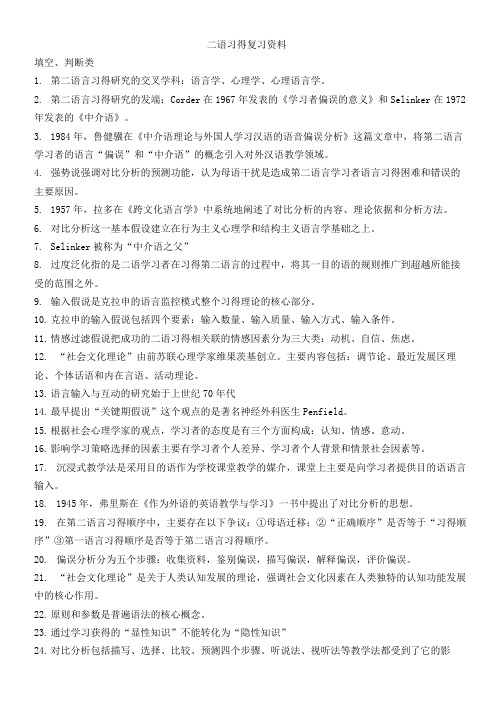
二语习得复习资料填空、判断类1.第二语言习得研究的交叉学科:语言学、心理学、心理语言学。
2.第二语言习得研究的发端:Corder在1967年发表的《学习者偏误的意义》和Selinker在1972年发表的《中介语》。
3.1984年,鲁健骥在《中介语理论与外国人学习汉语的语音偏误分析》这篇文章中,将第二语言学习者的语言“偏误”和“中介语”的概念引入对外汉语教学领域。
4.强势说强调对比分析的预测功能,认为母语干扰是造成第二语言学习者语言习得困难和错误的主要原因。
5.1957年,拉多在《跨文化语言学》中系统地阐述了对比分析的内容、理论依据和分析方法。
6.对比分析这一基本假设建立在行为主义心理学和结构主义语言学基础之上。
7.Selinker被称为“中介语之父”8.过度泛化指的是二语学习者在习得第二语言的过程中,将其一目的语的规则推广到超越所能接受的范围之外。
9.输入假说是克拉申的语言监控模式整个习得理论的核心部分。
10.克拉申的输入假说包括四个要素:输入数量、输入质量、输入方式、输入条件。
11.情感过滤假说把成功的二语习得相关联的情感因素分为三大类:动机、自信、焦虑。
12.“社会文化理论”由前苏联心理学家维果茨基创立。
主要内容包括:调节论、最近发展区理论、个体话语和内在言语、活动理论。
13.语言输入与互动的研究始于上世纪70年代14.最早提出“关键期假说”这个观点的是著名神经外科医生Penfield。
15.根据社会心理学家的观点,学习者的态度是有三个方面构成:认知、情感、意动。
16.影响学习策略选择的因素主要有学习者个人差异、学习者个人背景和情景社会因素等。
17.沉浸式教学法是采用目的语作为学校课堂教学的媒介,课堂上主要是向学习者提供目的语语言输入。
18.1945年,弗里斯在《作为外语的英语教学与学习》一书中提出了对比分析的思想。
19.在第二语言习得顺序中,主要存在以下争议:①母语迁移;②“正确顺序”是否等于“习得顺序”③第一语言习得顺序是否等于第二语言习得顺序。
第二语言习得研究的社会文化模式

Aljaafresh和Lantoff的纵向研究.
被试——一名成年英语学习者.
方法:支架教学法〔学生自己读作文,自己检查错误,之后和老师一起检查 错误,发现错误.老师会提供恰到好处的帮助,鼓励和指引学生.
结果:学习者自我纠正的能力提高了
〔三个体话语和内在言语
在认知功能从客体调控到他人调控再到自我调控的发展过程中,起到调节作 用的也从社会言语发展到个体话语,又进一步发展为内在言语.
第二,对习得水平的测量.学者们测量第二语言习得水平的手段 不尽相同.〔Kelly ,vp结构,Schmidt,交际能力
第三,文化适应程度和第二语言习得水平关系的动态性.〔目前 研究都在共时层面,不能全面反映二者之间的关系.
第四,被试数量.〔Maple,190名被试, Schmidt ,1名被试
2.内容—八项因素
〔1"社会主导模式"〔social dominance patterns指第二语言学习者群体与 目的与群体的平等程度,包括"主导地位"〔二战,日本,汉语、"从属地位"〔 美国西部印第安人、"平等地位"〔现在学习外语三个等级.平等地位最利于 第二语言习得.
平等程度不同,对第二语言习得效果的影响也不同.
〔4"凝聚程度"〔cohesive指第二语言习得群体内部成员间的密切程度.〔 北语的韩国人和尼泊尔人紧密程度低,学习者能获得更多的机会与目的语群 体交流,第二语言习得效果好.
〔5"群体大小"〔size,指第二语言习得群体人数的多少.在舒曼看来,紧密 程度和群体大小这两个因素直接相关,群体小,紧密程度低,习得效果好,群 体大,紧密程度高,习得效果与之相反.
【免费下载】二语习得定义题
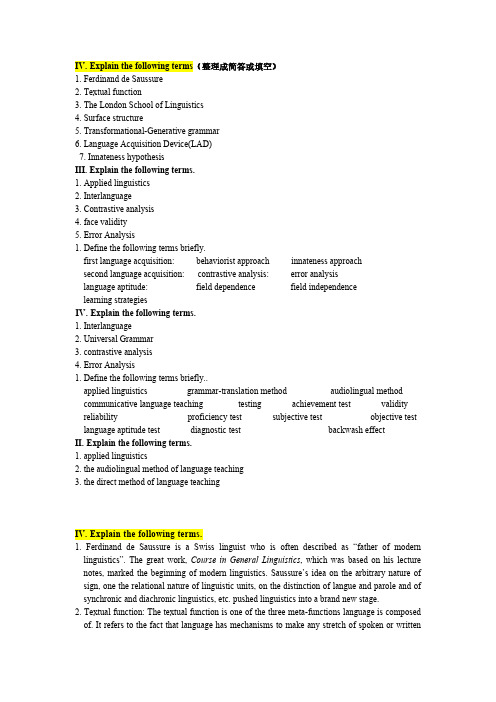
IV. Explain the following terms(整理成简答或填空)1. Ferdinand de Saussure2. Textual function3. The London School of Linguistics4. Surface structure5. Transformational-Generative grammar6. Language Acquisition Device(LAD)7. Innateness hypothesisIII. Explain the following terms.1. Applied linguistics2. Interlanguage3. Contrastive analysis4. face validity5. Error Analysis1. Define the following terms briefly.first language acquisition: behaviorist approach innateness approachsecond language acquisition: contrastive analysis: error analysislanguage aptitude: field dependence field independencelearning strategiesIV. Explain the following terms.1. Interlanguage2. Universal Grammar3. contrastive analysis4. Error Analysis1. Define the following terms briefly..applied linguistics grammar-translation method audiolingual method communicative language teaching testing achievement test validity reliability proficiency test subjective test objective test language aptitude test diagnostic test backwash effectII. Explain the following terms.1. applied linguistics2. the audiolingual method of language teaching3. the direct method of language teachingIV. Explain the following terms.1. Ferdinand de Saussure is a Swiss linguist who is often described as “father of modern linguistics”. The great work, Course in General Linguistics, which was based on his lecture notes, marked the beginning of modern linguistics. Saussure’s idea on the arbitrary nature of sign, one the relational nature of linguistic units, on the distinction of langue and parole and of synchronic and diachronic linguistics, etc. pushed linguistics into a brand new stage.2. Textual function: The textual function is one of the three meta-functions language is composed of. It refers to the fact that language has mechanisms to make any stretch of spoken or writtendiscourse into a coherent and unified text and make a living message different from a random list of sentences.3. The London School generally refers to the kind of linguistic scholarship in England. The man who turned linguistics proper into a recognized distinct academic subject in Britain was J.R. Firth.4. Surface structure: It is a term used in generative grammar to refer to the final stage in the syntactic representation of a sentence, which provides the input to the phonological component of the grammar, and which thus most closely corresponds to the structure we articulate and hear. For instance, “John is easy to please.” and “John is eager to please.” are two sentences with the same surface structure.5. Transformational-generative grammar is proposed by Noam Chomsky. He postulated asyntactic base of language (called deep structure), which consists of a series of phrase-structure rewrite rules, i.e., a series of (possibly universal) rules that generates the underlying phrase-structure of a sentence. The end result of a transformational-generative grammar is a surface structure that is identical to an actual sentence of a language, after the mediating of a series of rules (called transformations) that act upon the deep structures.6. Language Acquisition Device: LAD refers to an innate faculty of language in general with which children are born. It is posited by Chomsky, who argues that LAD probably consists of three elements: a hypothesis-maker, linguistic universal, and an evaluation procedure.7. The “Innateness Hypothesis” of child language acquisition was proposed by Noam Chomsky, who states that language are somewhat innate and that children are born with what he calls a language acquisition device, which is a unique kind of knowledge that fits them for language learning.III. Explain the following terms.1. Applied linguistics: It is a branch of linguistics which studies the application of linguistics in reality. For example, there are studies on multilingualism, language acquisition, first and second language teaching and learning.2. It refers to the type of language constructed by second or foreign language learners who are still in the process of learning a language. It’s a language system between the target language and the learner’s native language, and imperfect compared with the target language, but not mere translation from the learner’s native language. For example, when the Chinese student is learning English, he may make errors like “to touch the society”.3. Contrastive analysis is an approach to analysis of second language acquisition, based on a belief that a more effective teaching pedagogy would come out when the similarities and differences between native language and target language are taken into consideration. By such an analysis, it is supposed that some leaning difficulties could be predicted in terms of language transfer.4. Face validity: Unlike the other three forms of validity, face validity is based on the subjective judgment of an observer. If the test appears to be measuring what it intends to measure, the test is considered to have face validity.5 Errors are significant in telling the teacher what needs to be taught,in telling the researcherhow learning proceeds and those errors are a means whereby learners test their hypotheses about the language to be learnt. They are worth further probing Error Analysis involves,first independently or objectively,describing the learners’ interlanguage (that is,their version of the target language and the target language itself),then a comparison of the two is followedto locate mismatches. Different from contrastive analysis, Error Analysis, EA for short, gives 1ess consideration to learners’ native language. The procedure of Error Analysis consists of the following steps:(1) Recognition(2) Description.(3) Explanation.For example, explanation: the absence of an item that must appear in a well-formed utterance:e.g. She sleeping. Type of error: Omissions.1.First language acquisition: First language acquisition (L1 acquisition) is the term mostcommonly used to describe the process whereby children become speakers of their native language or languages, although some linguists prefer to use the term language learning. Behaviorist approach:Behaviorist approach holds that language is learned by a process of habit-formation. It is a standard “stimulus- response-imitation-reinforcement” approach. Innateness approach: Innateness approach treats human being’s ability in learning a language as a part of the biologically innate equipment and the infant is born with a language acquisition device (LAD). It regards language acquisition as a process of “hypothesis-deduction”. Second language acquisition:Second language acquisition (L2 acquisition) refers to the learning of a foreign language in addition to the mother tongue, inside or outside a classroom. Contrastive analysis: It is a method of analyzing languages for instructional purposes whereby a native language and target language are compared with a view to establishing points of difference likely to cause difficulties for learners.Error analysis: Error analysis (EA) refers to the study and analysis of the errors made by second and foreign language learners in order to identify causes of errors of common difficulties in language learning. It is an alternative to contrastive analysis.Language aptitude: The natural ability for learning an L2 is termed as language aptitude, not including intelligence, motivation, interest, etc.Field dependence: Field dependence is a learning style in which a learner tends to look at the whole of a learning task which contains many items. The learner has difficulty in studying a particular item when it occurs within a field of other items.Field independence: Field independence is a learning style in which a learner is able to identify or focus on particular items and is not distracted by other items in the background and context. Learning strategies: Learning strategies are the particular approaches or techniques that learners use to try to learn an L2. They can be behavioral or mental and they are typically problem-oriented.IV. Explain the following terms.1. Interlanguage. refers to the type of language constructed by second or foreign language learners who are still in the process of learning a language. It’s a language system between the target language and the learner’s native language, and imperfect compared with the target language, but not mere translation from the learner’s native language. For example, when the Chinese student is learning English, he may make errors like “to touch the society”.2. Universal grammar is a theory of linguistics postulating principles of grammar shared by all languages, thought to be innate to humans (linguistic nativism). It attempts to explain language acquisition in general, not describe specific languages. Universal grammar proposes a set of rules intended to explain language acquisition in child development.3. Contrastive analysis is an approach to analysis of second language acquisition, based on a belief that a more effective teaching pedagogy would come out when the similarities and differences between native language and target language are taken into consideration. By such an analysis, it is supposed that some leaning difficulties could be predicted in terms of language transfer.4. Errors are significant in telling the teacher what needs to be taught,in telling the researcher how learning proceeds and those errors are a means whereby learners test their hypotheses about the language to be learnt. They are worth further probing Error Analysis involves,first independently or objectively,describing the learners’ interlanguage (that is,their version of the target language and the target language itself),then a comparison of the two is followed to locate mismatches. Different from contrastive analysis, Error Analysis, EA for short, gives 1ess consideration to learners’ native language. The procedure of Error Analysis consists of the following steps:(1) Recognition(2) Description.(3) Explanation.For example, explanation: the absence of an item that must appear in a well-formed utterance:e.g. She sleeping. Type of error: Omissions.1. Applied linguistics: Applied linguistics is the study of language and linguistics in relation topractical issue, e.g. speech therapy, language teaching, testing, and translation.Grammar-translation method: Grammar-translation method refers to a method of foreign or second language teaching which makes use of translation and grammar study as the main teaching and learning activities.Audiolingual method: Audiolingual method refers to the teaching of a second language through imitation, repetition, and reinforcement. It emphasizes the teaching of speaking and listening before reading and writing and the use of mother tongue in the classroom is not allowed.Communicative language teaching: Communicative language teaching refers to the approach to foreign or second language teaching which emphasizes that the goal of language learning is communicative competence.Testing: It refers to the use of test, or the study of the theory and the practice of their use, development, evaluation, etc.Achievement test: Achievement test is a test which measures how much of a language someone has learned with reference to a particular course of study or program of instruction.Validity: Validity (in testing) refers to the degree to which a test measures what it is supposed to measure, or can be used successfully for the purposes for which it is intended. A number of different statistical procedures can be applied to a test to estimate its validity. Such procedures generally seek to determine what the test measures, and how well it does so.Reliability:Reliability(in testing) refers to a measure of the degree to which a test gives consistent results; a test is said to be reliable if it gives the same results when it is given on different occasions or when it is used by different people.Proficiency test: Proficiency test is a test which measures how much of a language someone has learned without bothering the syllabus, duration and manner of learning.Subjective test:Subject test refers to a test which is scored according to the personal judgment of the marker, such as an essay examination or translation.Objective test: Objective test is a test that can be marked without the use of the examiner’s personal judgment.Language aptitude test: Language aptitude test is a test which measures a person’s aptitude for second or foreign language learning and which can be used to identify those learners who are most likely to succeed.Diagnostic test: Diagnostic test refers to a test which is designed to show what skills or knowledge a learner knows or doesn’t know. For example, a diagnostic pronunciation test may be used to measure the learner’s pronunciation of English sounds. It would show which soundsa student is and is not able to pronounce. Diagnostic test may be used to find out how much alearner knows before beginning a language course.Backwash effect: Backwash effect refers to the effect of tests on classroom L2 teaching and learning.II. Explain the following terms.1. Applied linguistics. It is a branch of linguistics which studies the application of linguistics in reality. For example, there are studies on multilingualism, language acquisition, first and second language teaching and learning.2. It is the teaching of a second language through imitation, repetition, and reinforcement. It emphasizes the teaching of speaking and listening before reading and writing and the use of mother tongue in the classroom is not allowed.3. The learning of a second language by using the target language directly and associating speech form with action, gesture, objects and situations. Mother tongue is never or rarely used in the classroom, and the students supposedly acquire the second language in a way similar to the way they acquired their first language.。
第二语言习得概

一、名词解释1、语言能力是一种反映交际双方语言知识的心里语法,这种语法是一种“隐形的”而不是一种“显性的”语言知识。
2、语言表达指的是交际双方在语言的理解与生成过程中对其内在语法的运用。
3、前系统偏误:学习者还没有意识到目的语的特点的规则时发生的偏误,是凌乱无序的,学习者也不知道为什么选择了这种特定的规则形式。
4、系统偏误:学习者能够发现一些特定的规则,但这些规则往往是错误的,而且也不能纠正错的规则。
5、后系统偏误:学习者了解正确的规则,但在运用时出现了偏误。
6、僵化:是存在于“潜在的心理结构”中的一种机制,表现为某种母语背景的第二语言学习者会在目的语习得的某个阶段上停滞不前,无论学习者年龄大小,也无论其是否继续学习。
僵化的一个典型表现就是所谓的“回退”现象。
7、习得的知识:指学习者运用第二语言进行自然的交际,通过有意义的交际,学习者接触的是“可理解输入”。
8、学习的知识:指学习者把注意力集中在第二语言的形式特征上,通过有意识的学习方式获得第二语言规则的知识。
9、沉默期:主要指习得者没有足够能力讲话的那段时间,短至几小时,长达几个月。
在此期间,幼儿通过听对可理解性语言输入进行加工和整理。
经过这段沉默期后,幼儿似乎下意识地习得了输入的语言。
10、社会距离:指学习者与目的文化群体相互接触的程度而言的11、“融入策略”:指第二语言习得群体面对目的语群体文化时可能采取的态度和做法,包括“同化策略”、“保留策略”、“适应策略”三种。
12、“同化策略”:指第二语言习得群体面对目的语群体时放弃了自己原有的生活方式和价值观,接受了目的语群体的生活方式和价值观。
13、“适应策略”:指第二语言习得群体一方面保留了自己的生活方式和价值观,另一方面也接受了目的语群体的生活方式和价值观。
14、“文化休克”:学习者由于两种文化的差异而产生的精神紊乱、压抑、恐惧等。
15、“刺激贫乏论”:语言输入是贫乏的,学习者不可能通过外在的语言输入获得完整的语言能力。
第二语言习得

7、关亍第二语言习得研究的理论框架
R.Ellis关于第二语言习得研究的理论框架 R.Ellis 的三部著作: 1、第二语言习得概论 Understanding Second Language Acquisition,1985. 2、第二语言习得研究 The Study of Second Language Acquisition,1994. 3、第二语言习得 Second Language Acquisition,1997.
15
3、中介语理论
语言迁移(Language Transfer): “中介语”中的一些语言觃则、语言现象等等是从学习者的 第一语言转秱过来的; 对第二语言觃则的过度概括化(Overgeneralization): 比如“他把那个电影看了”这个句子可以看作是过度概括化的 结果; 语言训练的迁秱:有些“中介语”的成分是产生于教师的 训练方式 如,许多初学英语的中国人,当他们用英语跟外国人打招 呼时,常常说:“How are you?”,外国人回答说: “I’m all right, but quite busy.”(顺便提一下,在澳大 利亚墨尔本,则用“Good”回答。),中国人好像没有理会 外国人的答话,而是接着说“I’m fine too. Thank you.” 16 这可以看作是教学中反复迚行机械训练的结果;
14
3、中介语理论
产生:美国著名语言学家Selinker于1969年发表论文 “Language Transfer”,首先提出“Interlanguage”一词, 1972年发表论文“Interlanguage”,从次,正式揭开了第二 语言习得的研究。 他指出,中介语是一个独立的语言系统,它产生于学习 者试图掌握第二语言所作出的努力。也就是说,第二语言学习 者的语言系统具有独立性,这一系统在结构上处于本族语和目 的语之间的中间状态。当学习者试图运用第二语言迚行表达时, 他的语言运用就是一种中介语。中介语既包含母语的特征,也 包含目的语的特征,而又不两者都有区别,它是一种独立于本 族语和目的语,幵丏介于两者之间的一套独立的语言系统。
第一章 二语习得研究概述

二、一个独立的交叉学科(跨学科特点)
研究对象的性质
决定
跨学科的性质
1.学习者语言系统的研究
2.语言获得的一系列心理过程
3.学习者自身的研究
新领域:关于学习者本身的研究
主要包括两个方面:
(一)汉语学习者的策略研究,如学习策略和交际策 略,汉字学习策略 (二)汉语学习者汉语个体差异因素的研究,如态度、 动机,语言能力倾向、学习焦虑因素
汉语认知研究(语音、词汇、汉字) 海外习得研究
第二章 对比分析与偏误分析
第一节 对比分析
1.定义:将两种语言的系统进行共时比较,以揭示其 相同点和不同点的一种语言分析方法。
偏误来源
1)母语负迁移 2)目的语知识迁移 过度概括/过度泛化 3)文化因素负迁移 4)学习策略和交际策略的影响 学习策略方面:迁移、过度泛化、简化 交际策略方面:回避、语言转换 5)学习环境的影响
5)评估偏误:对偏误分析的标准进行评估 哪类偏误问题更严重 母语者和非母语者对偏误的评估不同 评估标准问题
国外大部分学者不刻意区分这两个概念,认为可以互
相替代,因此产生了“第一语言习得” “第二语言
习得”或“自然状态下的语言习得” “教学环境下
的语言习得”。
但国内学者试图严格区分两种不同的方式
母语习得
二语学习(学得) 有意识 有(课堂讲授) 有计划 有教材 通常无,非自然环境 有序输入 注重形式
学习
明晰的 有意识的 explicit learning formal learning conscious learning knowing about a language
《第二语言习得理论》复习纲要附参考答案
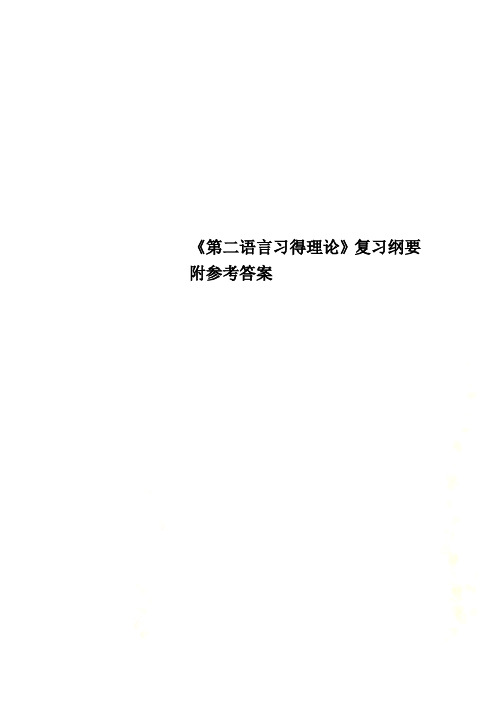
《第二语言习得理论》复习纲要附参考答案《第二语习得理论》复习纲要第一章引言1、二语习得研究者的研究对象一般是群体,而不是个体,你如何看待这个问题?10二语习得研究中,研究者的研究对象一般是群体,研究结论也是对某个群体而言。
但作为二语教学的老师,他更加关注一个个的个体,他关心的是如何让每一个学生很好的掌握第二语言。
这种情况下,二语习得研究者得到的结论,很可能对进行教学的老师的指导意义不是很大。
因此,二语习得研究者有必要加强对个体的研究,而不是局限于群体。
2、你认为什么是学外语的最好方式?9第二章人1、什么是一语习得的行为主义模型?提出者是?16-17一语习得的天生论模型的理论基础是乔姆斯基的转换生成语法,天生论认为人的大脑中有一个语言习得的机制,小孩出生后在任何一个语言环二语学习者对所学语言文化的态度影响学习过程,言语适应模型认为人们之间的交谈包含三个不同的过程,即交谈双方保持他们各自的说话方式,让各自的说话方式与对方显得越发不同,双方采用对方的说话特点以相互靠拢。
8、什么是foreigner talk?31当本族语者与非本族语者交谈时,所采用的简化的语言表达形式,可能会不符合语法规范。
9、人们一般认为学习者影响其学习效果,但Hermann提出了相反的看法,他提出的Hermann’s Resultative Hypothesis指什么?32一般认为,学习者对所学语言以及讲该语言的社会的态度会影响他学习该语言成功与否,但Hermann提出了另一个看法,称之为Hermann’s resultative hypothesis,认为可能恰好相反,学习者如果学习成功,就能促进他对该语言和讲这种语言的社会的正面态度,如果学习失败或者不太成功,他的态度会是消极的。
10、什么是语言规划?3211、人们一般把英语分为哪几个环?34-35我们一般把英语分为三个环,即inner circle,outer circle和expanding circle。
浅谈对克拉申二语习得理论的理解
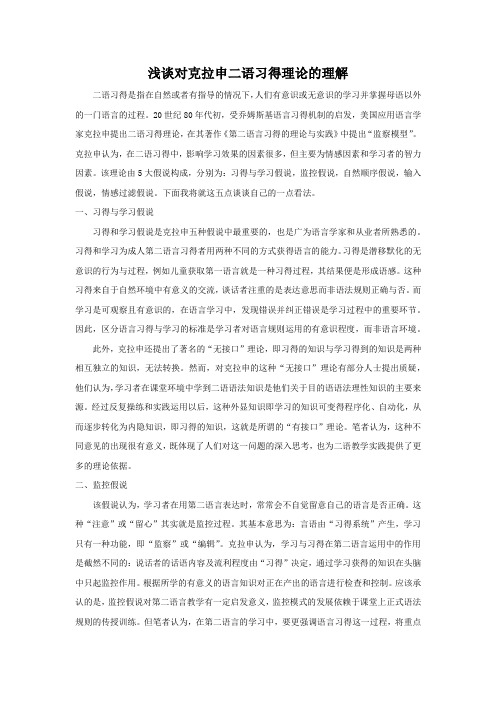
浅谈对克拉申二语习得理论的理解二语习得是指在自然或者有指导的情况下,人们有意识或无意识的学习并掌握母语以外的一门语言的过程。
20世纪80年代初,受乔姆斯基语言习得机制的启发,美国应用语言学家克拉申提出二语习得理论,在其著作《第二语言习得的理论与实践》中提出“监察模型”。
克拉申认为,在二语习得中,影响学习效果的因素很多,但主要为情感因素和学习者的智力因素。
该理论由5大假说构成,分别为:习得与学习假说,监控假说,自然顺序假说,输入假说,情感过滤假说。
下面我将就这五点谈谈自己的一点看法。
一、习得与学习假说习得和学习假说是克拉申五种假说中最重要的,也是广为语言学家和从业者所熟悉的。
习得和学习为成人第二语言习得者用两种不同的方式获得语言的能力。
习得是潜移默化的无意识的行为与过程,例如儿童获取第一语言就是一种习得过程,其结果便是形成语感。
这种习得来自于自然环境中有意义的交流,谈话者注重的是表达意思而非语法规则正确与否。
而学习是可观察且有意识的,在语言学习中,发现错误并纠正错误是学习过程中的重要环节。
因此,区分语言习得与学习的标准是学习者对语言规则运用的有意识程度,而非语言环境。
此外,克拉申还提出了著名的“无接口”理论,即习得的知识与学习得到的知识是两种相互独立的知识,无法转换。
然而,对克拉申的这种“无接口”理论有部分人士提出质疑,他们认为,学习者在课堂环境中学到二语语法知识是他们关于目的语语法理性知识的主要来源。
经过反复操练和实践运用以后,这种外显知识即学习的知识可变得程序化、自动化,从而逐步转化为内隐知识,即习得的知识,这就是所谓的“有接口”理论。
笔者认为,这种不同意见的出现很有意义,既体现了人们对这一问题的深入思考,也为二语教学实践提供了更多的理论依据。
二、监控假说该假说认为,学习者在用第二语言表达时,常常会不自觉留意自己的语言是否正确。
这种“注意”或“留心”其实就是监控过程。
其基本意思为:言语由“习得系统”产生,学习只有一种功能,即“监察”或“编辑”。
二语习得和语言教学

研究领域:
2020/12/24
(1)L2学习者如何理解第二语言,如何用第二语言 进行表达;
(2)L2学习者获得第二语言经历哪些阶段; (3)L2学习者的语言系统是如何产生的; (4)影响第二语言习得因素有哪些; (5)L2学习者的语言习得机制是怎样构成的; (6)第二语言习得涉及哪些心理过程; (7)L2学习者习得第二语言采取哪些策略。
2020/12/24
威尔士:关于能力,以下两点一般没有异议:
✓ 能力即知识,和实际表现相对,表现只能部分反映能力 ✓ 能力概念需要排除非本质的内容。 ➢ 乔姆斯基的能力概念范围太窄,只指抽象的语法能力。一个完整的语
言理论,必须既能解释语言运用的创造性,也能说明语境的重要作用 。除了语法能力外,语言能力还包括使话语具有“语境得体性”能力 。
——乔姆斯基
2020/12/24
三者的关系: 1.能力等于抽象的知识。 2.能力和水平在某种意义上是同义词,与表现对立。 3.正常情况下,能力和表现基本一致。能力决定表现,表现反映能力。 4.能力和水平都比较抽象,不能直接观察和测量。在语言教学中,通常是 根据学生的表现(测试)来推测他的水平和能力;在语言研究中,通常采 用反思、直觉判断(判断句子合不合法等方法来推测语言能力。
• 二语环境和外语环境的对立,取决于目的语在社区中是否常用 • 二语环境和外语环境的区分并不简单 • 环境对语言学习的影响有不同看法:触发作用;制约作用
2020/12/24
2.语言习得
母语习得——二语习得 语言习得研究中,有两个基本问题,“逻辑问题”和“发展问题”。 逻辑问题:语言习得是如何成为可能的?(环境论;先天论) 发展问题:怎样解释语言习得遵循一定的发展顺序和步骤? 对于逻辑问题,第二语言习得的表述略有不同:有些人二语水平很高,但 大多数人却不是这样,为什么? 第二语言学习是否只要能够复制出跟母语习得环境一样环境就行了?(直接法) 第二语言学习过程和第一语言学习过程是否相同?
学科英语教育考研第二语言习得研究整理

学科英语教育考研第二语言习得研究整理第一章1.目的语:又称“目的语”,一般指学习者正在学习的语言。
这种语言可能是他的第二语言,第三语言,甚至第四语言。
它强调任何语言学习者所学习的语言都与学习者的语言习得环境无关。
例如,无论美国学生在美国还是在中国学习汉语,他们的目标语言都是汉语。
如果他们同时学习法语,法语也是他们的目标语言。
对于第二语言学习者来说,母语对目标语言习得有重要影响。
2.第一语言:是我们从小就学会的语言,简称\一语\,也叫\母语\。
第二语言:在掌握第一语言之后,人们还可以继续学习并在不同程度上掌握的语言,简称“二语。
“第一语言”通常是指学习者的母语或本族语而言的。
尽管有些时候,学习者的第一语言并不是他的母语或本族语。
“第二语言”是相对于学习者习得的第一语言之外的任何一种其他语言而言的。
因此,“第二语言”自然包含第三、第四或更多的其他语言。
3.第二语言习得是指人们在习得母语(第一语言)的基础上习得另一种或几种语言的过程。
二语习得这个术语也可以指一门学科,即研究第二语言习得的过程和规律。
它是语言学的一个分支,也可以被视为心理学的一个分支。
跨学科和边缘学科。
4.外语习得是指人们学习外语的过程。
外语指外国的语言,属于第二语言,但第二语言却不一定都是外语,二者所指范围不同,第二语言与外语是包容关系,第二语言所指的范围比外语要广。
二语习得的环境也同外语习得的环境不同。
第二章1.对比分析分为“强势说”和“弱势说”两者最大的差别是目标不同strong理论强调对比分析的预测功能,认为母语干扰是第二语言学习者语言习得困难和错误的主要甚至唯一原因。
强理论强调“预测”,高估比较的预测功能,过于绝对。
这是一种极端的观点。
后来的实证研究证明,第一语言不是学习者错误的唯一或主要原因,比较分析很难准确预测学习者可能遇到的困难。
弱势说不主张通过差异的对比来预测学习者的难点,而强调对学习者的错误进行解释;主张从学习者的错误分析着手,在母语与目的语差异对比的基础上试图说明学习者产生错误的原因。
语言学 二语习得

tan
is learning.
Second Language Acquisition (SLA) The study of SLA, as an independent field of inquiry, started in the late 1960’s, and flourished in the 1970’s and 80’s, perhaps as a result of the resurgence of interest in the internal mechanisms of the language teaching and learning process.
Interlingual errors mainly result from crosslinguistic interference at different levels such as phonological, lexical, grammatical or discoursal etc. For examples, a. Substitution of [t] for [ ] and [d] for [ ]: threetree, thisdis. b. Shortening of long vowels: sheepship, meetmit
e.g.walked, watched, washed… *rided, *goed, *doed, *eated… Jane advise me to give up smoking. Jane told me to give up smoking. *Jane hoped me to give up smoking. *Jane suggested me to give up smoking. *I losed the game. *There are ten sheeps. *I was devoted to do this job.)
第二语言习得研究 考试资料
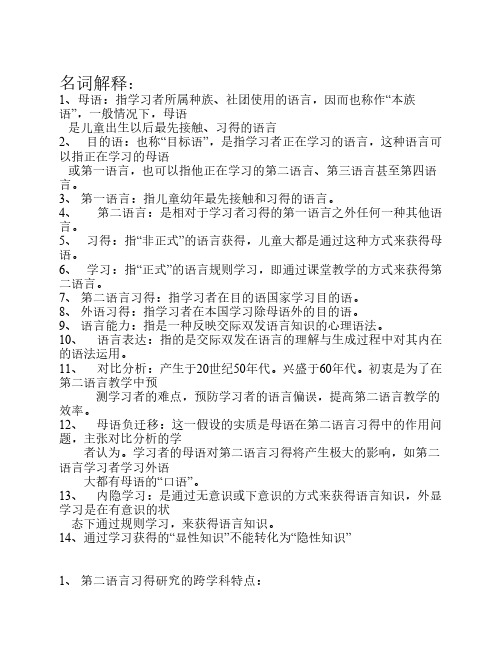
名词解释:1、母语:指学习者所属种族、社团使用的语言,因而也称作“本族语”,一般情况下,母语是儿童出生以后最先接触、习得的语言2、目的语:也称“目标语”,是指学习者正在学习的语言,这种语言可以指正在学习的母语或第一语言,也可以指他正在学习的第二语言、第三语言甚至第四语言。
3、第一语言:指儿童幼年最先接触和习得的语言。
4、第二语言:是相对于学习者习得的第一语言之外任何一种其他语言。
5、习得:指“非正式”的语言获得,儿童大都是通过这种方式来获得母语。
6、学习:指“正式”的语言规则学习,即通过课堂教学的方式来获得第二语言。
7、第二语言习得:指学习者在目的语国家学习目的语。
8、外语习得:指学习者在本国学习除母语外的目的语。
9、语言能力:指是一种反映交际双发语言知识的心理语法。
10、语言表达:指的是交际双发在语言的理解与生成过程中对其内在的语法运用。
11、对比分析:产生于20世纪50年代。
兴盛于60年代。
初衷是为了在第二语言教学中预测学习者的难点,预防学习者的语言偏误,提高第二语言教学的效率。
12、母语负迁移:这一假设的实质是母语在第二语言习得中的作用问题,主张对比分析的学者认为。
学习者的母语对第二语言习得将产生极大的影响,如第二语言学习者学习外语大都有母语的“口语”。
13、内隐学习:是通过无意识或下意识的方式来获得语言知识,外显学习是在有意识的状态下通过规则学习,来获得语言知识。
14、通过学习获得的“显性知识”不能转化为“隐性知识”1、第二语言习得研究的跨学科特点:语言学与心理学有着交叉与重合,构成了心理语言学,第二语言习得研究与语言学密切相关,但是在学科的划分上,它并不属于语言学,同样,第二语言习得研究与心理语言学也密切相关,但他既不属于心理语言学也不属于心理学。
2、第二语言习得研究的发端:第二语言习得研究的发端可以追溯到20世纪60年代末,Corder1967年发表的《学习者偏误的意义》明确提出了第二语言习得的研究对象,标志着第二语言习得研究成为一个相对独立的研究领域;Selinker1972发表的《中介语》,系统地阐述了“中介语”理论假设,更加明确的提出了第二语言习得研究的对象,即“学习者的语言系统”,因此,这两人的文章被称为第二语言习得研究的“开山之作”,成为建立第二语言习得研究学科的标志。
《二语言习得》课件

异:了解目标语言的文化背景和语言习惯 交际技巧:掌握有效的沟通技巧,如倾听、表达、肢体语言等 文化适应:尊重并适应目标文化的价值观和习俗 文化交流:积极参与文化交流活动,提高跨文化交际能力
自主学习策略
添加标题
定义与特点:自主学习策略是一种学习者自我管理、自我监控和自我评估的学习方式,具有主动性、 独立性和有效性的特点。
社会文化理论
定义:社会文化理论是一种研究语言习得过程中社会文化因素的理论
核心概念:中介、最近发展区、支架等
理论观点:强调语言习得过程中社会文化因素的重要性,认为语言是社会文化交流的工具,语言习得是在社会文 化环境中通过与他人互动而实现的
实践应用:支架式教学、合作学习等
交互理论
定义:交互理论 是一种二语言习 得理论,强调学 习者通过与目标 语言的母语者进 行交流互动来提 高语言能力。
添加标题
理论基础:自主学习策略的理论基础包括建构主义学习理论、人本主义学习理论等,强调学习者的 主体性和自主性。
添加标题
实施步骤:自主学习策略的实施步骤包括制定学习计划、选择学习资源、进行自我监控和评估等, 旨在提高学习者的学习效果和自主学习能力。
添加标题
优势与局限性:自主学习策略的优势在于能够激发学习者的学习兴趣和动力,提高学习者的自主学习能力和终身学习能力; 其局限性在于需要学习者具备一定的自我管理和自我监控能力,同时也需要教师提供必要的指导和支持。
精读:仔细阅读文章,理解细 节
略读:快速浏览文章,寻找特 定信息
查读:查找特定信息,理解文 章结构
写作技巧与方法
确定主题和目标受众
收集相关资料和信息
制定写作计划和提纲
注重语言表达和修辞 手法
反复修改和完善文稿
二语习得
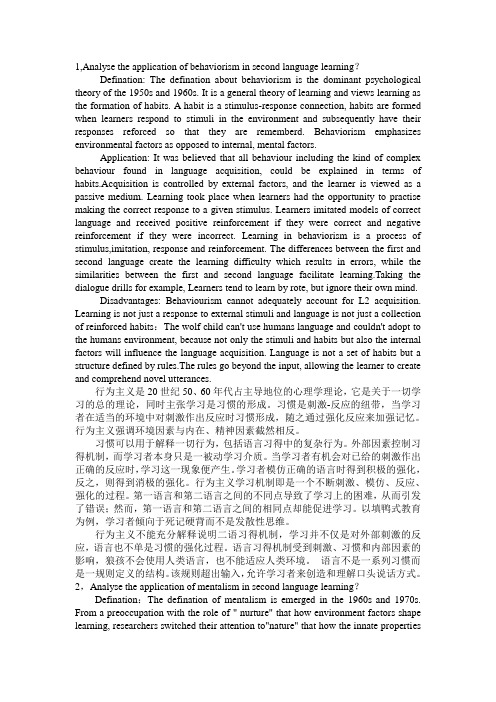
1,Analyse the application of behaviorism in second language learning?Defination: The defination about behaviorism is the dominant psychological theory of the 1950s and 1960s. It is a general theory of learning and views learning as the formation of habits. A habit is a stimulus-response connection, habits are formed when learners respond to stimuli in the environment and subsequently have their responses reforced so that they are rememberd. Behaviorism emphasizes environmental factors as opposed to internal, mental factors.Application: It was believed that all behaviour including the kind of complex behaviour found in language acquisition, could be explained in terms of habits.Acquisition is controlled by external factors, and the learner is viewed as a passive medium. Learning took place when learners had the opportunity to practise making the correct response to a given stimulus. Learners imitated models of correct language and received positive reinforcement if they were correct and negative reinforcement if they were incorrect. Learning in behaviorism is a process of stimulus,imitation, response and reinforcement. The differences between the first and second language create the learning difficulty which results in errors, while the similarities between the first and second language facilitate learning.Taking the dialogue drills for example, Learners tend to learn by rote, but ignore their own mind.Disadvantages: Behaviourism cannot adequately account for L2 acquisition. Learning is not just a response to external stimuli and language is not just a collection of reinforced habits:The wolf child can't use humans language and couldn't adopt to the humans environment, because not only the stimuli and habits but also the internal factors will influence the language acquisition. Language is not a set of habits but a structure defined by rules.The rules go beyond the input, allowing the learner to create and comprehend novel utterances.行为主义是20世纪50、60年代占主导地位的心理学理论,它是关于一切学习的总的理论,同时主张学习是习惯的形成。
新编小学英语第二章 语言与语言习得

讨论分析: (1)狼孩为什么不能说话?
(2)狼孩的故事告诉我们什么样的事实?
一、语言的定义 语言是一种特殊的社会现象,是人类用于交际和思维的音义结合 的符号系统。 二、语言的功能 【活动讨论】 在进行语言学习的过程中,语言具有哪些功能?请分组讨论,写 出1~3个功能。 (一)语言的社会功能 语言的社会功能主要有交际功能和标志功能。
第二章
语言与语言习得
第一节
【案例分析】
语言的功能
请阅读狼孩的故事,和同学一起讨论分析后面的问题。
在1920年,在印度加尔各答东北的一个名叫米德纳波尔的小城,一个牧师在一个
洞穴深处发现了两个裸体的小女孩,一个大约七八岁,一个大约两岁。这两个小女 孩被送到米德纳波尔的孤儿院去抚养,还给她们取了名字,大的叫卡玛拉,小的叫 阿玛拉。到了第二年阿玛拉死了,而卡玛拉一直活到1929年。这就是曾经轰动一时 的“狼孩”一事。 据研究,七八岁的卡玛拉刚被发现时,她只懂得一般6个月婴儿所懂得的事,花了 很大气力都不能使她很快地适应人类的生活方式,2年后才会直立,6年后才艰难地 学会独立行走,但快跑时还得四肢并用。直到死也未能真正学会讲话:4年内只学会 6个词,听懂几句简单的话,7年时才学会45个词并勉强地学几句话。在最后的3年中, 卡玛拉终于学会在晚上睡觉,她也怕黑暗了。很不幸,就在她开始朝人的生活习性 迈进时,她死去了。辛格估计,卡玛拉死时已16岁左右,但她的智力只相当于三四 岁的孩子!
美国心理学家华生(Watson)创立了行为主义理论。
2. 刺激—反应论积极意义 3. 刺激—反应论的不足
(二)先天论
1. 先天论主要观点
人类先天具有一种习得语言的特殊能力,表现为儿童头脑中有 一种受遗传因素决定的“语言习得机制”(LAD)。又称为 “普遍语法”(universal grammar)。 先天论不完全否认后天语言环境的作用,但把语言环境的作用 看得非常小,只是起着激发LAD工作的作用,是第二性的。 2. 对先天论的评价 (三)认知论(先天与后天相互作用论) 1. 认知论的主要观点 儿童头脑中没有神秘的语言习得机制,更不存在普遍语法,但 人类有先天的认知机制和认知能力。
- 1、下载文档前请自行甄别文档内容的完整性,平台不提供额外的编辑、内容补充、找答案等附加服务。
- 2、"仅部分预览"的文档,不可在线预览部分如存在完整性等问题,可反馈申请退款(可完整预览的文档不适用该条件!)。
- 3、如文档侵犯您的权益,请联系客服反馈,我们会尽快为您处理(人工客服工作时间:9:00-18:30)。
IV. Explain the following terms(整理成简答或填空)1. Ferdinand de Saussure2. Textual function3. The London School of Linguistics4. Surface structure5. Transformational-Generative grammar6. Language Acquisition Device(LAD)7. Innateness hypothesisIII. Explain the following terms.1. Applied linguistics2. Interlanguage3. Contrastive analysis4. face validity5. Error Analysis1. Define the following terms briefly.first language acquisition: behaviorist approach innateness approachsecond language acquisition: contrastive analysis: error analysislanguage aptitude: field dependence field independencelearning strategiesIV. Explain the following terms.1. Interlanguage2. Universal Grammar3. contrastive analysis4. Error Analysis1. Define the following terms briefly..applied linguistics grammar-translation method audiolingual method communicative language teaching testing achievement test validity reliability proficiency test subjective test objective test language aptitude test diagnostic test backwash effectII. Explain the following terms.1. applied linguistics2. the audiolingual method of language teaching3. the direct method of language teachingIV. Explain the following terms.1. Ferdinand de Saussure is a Swiss linguist who is often described as “father of modern linguistics”. The great work, Course in General Linguistics, which was based on his lecture notes, marked the beginning of modern linguistics. Saussure’s idea on the arbitrary nature of sign, one the relational nature of linguistic units, on the distinction of langue and parole and of synchronic and diachronic linguistics, etc. pushed linguistics into a brand new stage.2. Textual function: The textual function is one of the three meta-functions language is composed of. It refers to the fact that language has mechanisms to make any stretch of spoken or writtendiscourse into a coherent and unified text and make a living message different from a random list of sentences.3. The London School generally refers to the kind of linguistic scholarship in England. The man who turned linguistics proper into a recognized distinct academic subject in Britain was J.R. Firth.4. Surface structure: It is a term used in generative grammar to refer to the final stage in the syntactic representation of a sentence, which provides the input to the phonological component of the grammar, and which thus most closely corresponds to the structure we articulate and hear. For instance, “John is easy to please.” and “John is eager to please.” are two sentences with the same surface structure.5. Transformational-generative grammar is proposed by Noam Chomsky. He postulated asyntactic base of language (called deep structure), which consists of a series of phrase-structure rewrite rules, i.e., a series of (possibly universal) rules that generates the underlying phrase-structure of a sentence. The end result of a transformational-generative grammar is a surface structure that is identical to an actual sentence of a language, after the mediating of a series of rules (called transformations) that act upon the deep structures.6. Language Acquisition Device: LAD refers to an innate faculty of language in general with which children are born. It is posited by Chomsky, who argues that LAD probably consists of three elements: a hypothesis-maker, linguistic universal, and an evaluation procedure.7. The “Innateness Hypothesis” of child langua ge acquisition was proposed by Noam Chomsky, who states that language are somewhat innate and that children are born with what he calls a language acquisition device, which is a unique kind of knowledge that fits them for language learning.III. Explain the following terms.1. Applied linguistics: It is a branch of linguistics which studies the application of linguistics in reality. For example, there are studies on multilingualism, language acquisition, first and second language teaching and learning.2. It refers to the type of language constructed by second or foreign language learners who are still in the process of learning a language. It’s a language system between the target language and the learner’s native language, and imperfect compared with the target language, but not mere translation from the learner’s native language. For example, when the Chinese student is learning English, he may make errors like “to touch the society”.3. Contrastive analysis is an approach to analysis of second language acquisition, based on a belief that a more effective teaching pedagogy would come out when the similarities and differences between native language and target language are taken into consideration. By such an analysis, it is supposed that some leaning difficulties could be predicted in terms of language transfer.4. Face validity: Unlike the other three forms of validity, face validity is based on the subjective judgment of an observer. If the test appears to be measuring what it intends to measure, the test is considered to have face validity.5 Errors are significant in telling the teacher what needs to be taught,in telling the researcher howlearning proceeds and those errors are a means whereby learners test their hypotheses about the language to be learnt. They are worth further probing Error Analysis involves,first independently or objectively,describing the learners’ interlanguage (that is,their version of the target language and the target language itself),then a comparison of the two is followed tolocate mismatches. Different from contrastive analysis, Error Analysis, EA for short, gives 1ess consideration to learners’ native language. The procedure of Error Analysis consists of the following steps:(1) Recognition(2) Description.(3) Explanation.For example, explanation: the absence of an item that must appear in a well-formed utterance:e.g. She sleeping. Type of error: Omissions.1.First language acquisition: First language acquisition (L1 acquisition) is the term mostcommonly used to describe the process whereby children become speakers of their native language or languages, although some linguists prefer to use the term language learning. Behaviorist approach:Behaviorist approach holds that language is learned by a process of habit-formation. It is a standard “stimulus- response-imitation-reinforcement” approach. Innateness approach: Innateness approach treats human being’s ability in learning a language as a part of the biologically innate equipment and the infant is born with a language acquisition device (LAD). It regards language acquisition as a process of “hypothesis-deduction”. Second language acquisition:Second language acquisition (L2 acquisition) refers to the learning of a foreign language in addition to the mother tongue, inside or outside a classroom. Contrastive analysis: It is a method of analyzing languages for instructional purposes whereby a native language and target language are compared with a view to establishing points of difference likely to cause difficulties for learners.Error analysis: Error analysis (EA) refers to the study and analysis of the errors made by second and foreign language learners in order to identify causes of errors of common difficulties in language learning. It is an alternative to contrastive analysis.Language aptitude: The natural ability for learning an L2 is termed as language aptitude, not including intelligence, motivation, interest, etc.Field dependence: Field dependence is a learning style in which a learner tends to look at the whole of a learning task which contains many items. The learner has difficulty in studying a particular item when it occurs within a field of other items.Field independence: Field independence is a learning style in which a learner is able to identify or focus on particular items and is not distracted by other items in the background and context. Learning strategies: Learning strategies are the particular approaches or techniques that learners use to try to learn an L2. They can be behavioral or mental and they are typically problem-oriented.IV. Explain the following terms.1. Interlanguage. refers to the type of language constructed by second or foreign language learners who are still in the process of learning a language. It’s a language system between the target language and the learner’s native language, and imperfect compared with the target language, but not mere translation from the learner’s native language. For example, when the Chinese student is learning English, he may make errors like “to touch the society”.2. Universal grammar is a theory of linguistics postulating principles of grammar shared by all languages, thought to be innate to humans (linguistic nativism). It attempts to explain language acquisition in general, not describe specific languages. Universal grammar proposes a set of rules intended to explain language acquisition in child development.3. Contrastive analysis is an approach to analysis of second language acquisition, based on a belief that a more effective teaching pedagogy would come out when the similarities and differences between native language and target language are taken into consideration. By such an analysis, it is supposed that some leaning difficulties could be predicted in terms of language transfer.4. Errors are significant in telling the teacher what needs to be taught,in telling the researcher how learning proceeds and those errors are a means whereby learners test their hypotheses about the language to be learnt. They are worth further probing Error Analysis involves,first independently or objectively,describing the learners’ interlanguage (that is,their version of the target language and the target language itself),then a comparison of the two is followed to locate mismatches. Different from contrastive analysis, Error Analysis, EA for short, gives 1ess consideration to learners’native language. The procedure of Error Analysis consists of the following steps:(1) Recognition(2) Description.(3) Explanation.For example, explanation: the absence of an item that must appear in a well-formed utterance:e.g. She sleeping. Type of error: Omissions.1. Applied linguistics: Applied linguistics is the study of language and linguistics in relation topractical issue, e.g. speech therapy, language teaching, testing, and translation.Grammar-translation method: Grammar-translation method refers to a method of foreign or second language teaching which makes use of translation and grammar study as the main teaching and learning activities.Audiolingual method: Audiolingual method refers to the teaching of a second language through imitation, repetition, and reinforcement. It emphasizes the teaching of speaking and listening before reading and writing and the use of mother tongue in the classroom is not allowed.Communicative language teaching: Communicative language teaching refers to the approach to foreign or second language teaching which emphasizes that the goal of language learning is communicative competence.Testing: It refers to the use of test, or the study of the theory and the practice of their use, development, evaluation, etc.Achievement test: Achievement test is a test which measures how much of a language someone has learned with reference to a particular course of study or program of instruction.Validity: Validity (in testing) refers to the degree to which a test measures what it is supposed to measure, or can be used successfully for the purposes for which it is intended. A number of different statistical procedures can be applied to a test to estimate its validity. Such procedures generally seek to determine what the test measures, and how well it does so.Reliability:Reliability(in testing) refers to a measure of the degree to which a test gives consistent results; a test is said to be reliable if it gives the same results when it is given on different occasions or when it is used by different people.Proficiency test: Proficiency test is a test which measures how much of a language someone has learned without bothering the syllabus, duration and manner of learning.Subjective test:Subject test refers to a test which is scored according to the personal judgment of the marker, such as an essay examination or translation.Objective test: Objective test is a test that can be marked without the use of the examiner’s personal judgment.Language aptitude test: Language aptitude test is a test which measures a person’s aptitude for second or foreign language learning and which can be used to identify those learners who are most likely to succeed.Diagnostic test: Diagnostic test refers to a test which is designed to show what skills or knowledge a learner knows or doesn’t know. For example, a diagnostic pronunciation test may be used to measure the learner’s pronunciation of English sounds. It would show which soundsa student is and is not able to pronounce. Diagnostic test may be used to find out how much alearner knows before beginning a language course.Backwash effect: Backwash effect refers to the effect of tests on classroom L2 teaching and learning.II. Explain the following terms.1. Applied linguistics. It is a branch of linguistics which studies the application of linguistics in reality. For example, there are studies on multilingualism, language acquisition, first and second language teaching and learning.2. It is the teaching of a second language through imitation, repetition, and reinforcement. It emphasizes the teaching of speaking and listening before reading and writing and the use of mother tongue in the classroom is not allowed.3. The learning of a second language by using the target language directly and associating speech form with action, gesture, objects and situations. Mother tongue is never or rarely used in the classroom, and the students supposedly acquire the second language in a way similar to the way they acquired their first language.。
